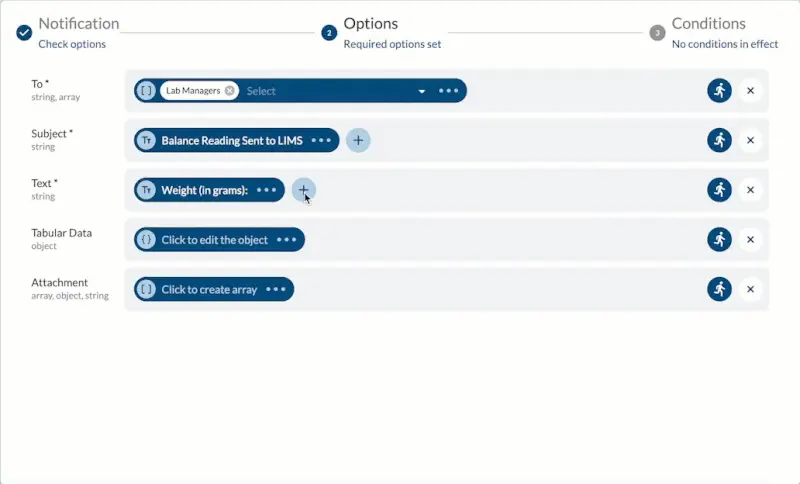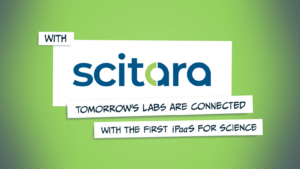
Many of the tasks you face daily in the lab are routine, yet they lack interoperability and automation, sometimes requiring duplication of effort, redundant or manual data entry, or manual transfer of data and tasks between unconnected devices. Consequently, many labs are vulnerable to errors, burdened by labor-intensive tasks, and lacking a coherent set of rules-driven and automated workflows.
Building on the Scitara DLX Connection infrastructure discussed in our last blog, Scitara Orchestrations directly address the burdens caused by the lack of meaningful lab automation. Lab Data Automation is at the core of what we do. Data from various sources, including instruments, applications, and databases, can be challenging to manage and mobilize, especially for labs handling multiple projects simultaneously. Scitara DLX’s automation technology simplifies configuring automated workflows, removing the complexity and inefficiency of manual processes.
What is an Orchestration?
An Orchestration is a self-contained automated or semi-automated workflow containing business logic and rules defining the mobilization of data across Scitara DLX Connections. Orchestrations provide the following functionality:
- Partially or fully automate lab instrument integration across multiple instruments, applications, or other lab resource devices.
- Reformat data and/or perform calculations in flight.
- Chain multiple Orchestrations together.
- View all transactions performed during an Orchestration through the Orchestration Execution page or the Scitara DLX Event Stream, supporting lab data integrity and compliance.

Users may create and modify Orchestrations from the DLX UI, empowering the ability to seamlessly manage multi-directional workflows and transform data in-flight across all Scitara DLX Connections that are configured on the platform.
An Orchestration is a self-contained automated or semi-automated workflow containing business logic and rules defining the mobilization of data across Scitara DLX Connections. Orchestrations provide the following functionality:
- Partially or fully automate manual laboratory tasks across multiple instruments, applications, or other lab resource devices.
- Reformat data and/or perform calculations in flight.
- Chain multiple Orchestrations together.
- View all transactions performed during an Orchestration through the Orchestration Execution page or the Scitara DLX Event Stream, supporting data integrity and compliance.
Users may create and modify Orchestrations from the DLX UI, empowering the ability to seamlessly manage multi-directional workflows and transform data in-flight across all Scitara DLX Connections that are configured on the platform.
Building an Orchestration
Triggers
An Orchestration is triggered through one of the following three methods:

Orchestration Steps
Orchestrations link multiple Connections and transform steps together, effectively establishing logical workflows within a lab. Once triggered, an Orchestration may autonomously initiate a sequence of actions, eliminating the need for additional user interaction. Alternatively, it can be configured to incorporate user input steps. The output of each step feeds into subsequent steps. From sending a notification about an Orchestration execution to conducting query events based on specific criteria, these steps are crucial to defining the flow of data and action within an Orchestration.
Assisting in Orchestration creation, the visual expression editor provides a powerful asset, enabling intuitive field mapping and simplifying the data transformation process. Users can easily manipulate and customize the functionality of their expressions through a straightforward UI.

Additional criteria for each trigger step may be configured. Available trigger conditions are defined by the trigger type and any relevant Connections.
What Can Be Automated?
Scitara DLX Orchestrations offer a versatile suite of configurable tools that significantly enhance data mobility in scientific laboratories. In addition to facilitating seamless data transformation, thereby enhancing its value to researchers and scientists across various domains, it can also:
Mobilize Data Across Instruments, Applications, and Platforms
Scitara DLX Orchestrations empower seamless data transfer within and across scientific labs, bridging the gaps between instruments and applications. They provide controlled adaptable automation while ensuring accessibility and empowering our users. With interactive user dialogues, DLX Orchestrations mimic human interactions and foster collaboration. This automation reduces manual effort, ensuring both precise and consistent data transfer.
Trigger Analysis Workflows Based on Data Criteria
Enabling automatic analysis workflows based on specific data criteria accelerates scientific research. With DLX Orchestration, scientists monitor data and trigger analyses when predefined conditions are met, swiftly revealing valuable insights and trends, expediting research, and enhancing data-driven decision-making.
Support for Lab, Site, and Global Deployment
Scitara DLX Orchestrations’ scalability supports standardized workflows across multiple labs and research facilities, ensuring consistent data management, analysis, and reporting practices. This unified approach minimizes disparities, fosters data consistency and comparability, and simplifies the sharing of best practices while centralizing processes across labs.
Benefits of Using Scitara DLX Orchestrations
For modern laboratory management, Scitara DLX Orchestrations enhance automation to optimize the streamline of data transfer and processing tasks. With an unwavering focus on precision and efficiency, Orchestrations deliver significant and unique benefits that elevate laboratory operations to reach optimal conditions, including:
- Increased data integrity: Orchestrations enhance data integrity by automating tasks, reducing human errors and tracking data mobility payload information thus maintaining accurate and reliable data for improved workflow quality and analyses.
- Improved compliance: Orchestrations are vital for adhering to regulatory standards like GMP and GLP by enforcing protocols for data in flight. Orchestrations reduce non-compliance risks, leveraging the Scitara Event Stream and Audit trail for traceability.
- Enhanced collaboration: Utilizing Orchestrations enhances collaboration in the laboratory by facilitating more effective teamwork among scientists, QA teams, Regulatory Affairs (RA) officials, and other stakeholders through streamlined workflows, resulting in better decision-making and a more cohesive project approach.
- Increased agility: The flexibility of Orchestrations empowers labs to quickly adapt to changes, including regulations, technology, and research priorities, without labor-intensive reconfiguration, ensuring competitiveness and efficiency in a dynamic scientific landscape.
- Flexibility: Orchestrations enable labs to swiftly integrate new methodologies, tools, or protocols, ensuring relevance by customizing and adapting workflows as needed to align with emerging trends in their industries.
- Commercial product: The user-friendly configuration process for Orchestrations empowers users to create their own solutions, ensuring accessibility and bolstering confidence through effective training.
Summary
As technology continues to evolve, so does the landscape of laboratory automation. Scitara DLX automation capabilities empower users to design and modify data exchange workflows, expanding lab connectivity across various lab components. By streamlining data workflows and enabling seamless automation, Scitara DLX Orchestrations are a cornerstone of modern laboratory practices, propelling scientific research and innovation to new heights.
While Scitara DLX Orchestration technologies offer a robust range of automation abilities to produce scalable and reliable data pipelines, another crucial aspect of Scitara DLX is its monitoring capability. Built-in monitoring functions within the platform allow instruments and other lab resources, along with the established data workflows, to be monitored for compliance purposes, promoting data integrity, establishing an audit trail, and showcasing the progress of each Orchestration. For more insights into Scitara DLX Monitoring, check out our upcoming blog that explores how Scitara DLX leverages our Monitoring functionality to provide users with vital insights in their modern labs. With our solutions, you can finally achieve a fully digital lab and realize the vision of a paperless laboratory.

Contact us today to schedule a demo of Scitara DLX and discover how our Orchestrations empower the mobilization and transformation of data enabling seamless transitions across multiple end points, both within and beyond the laboratory setting.
